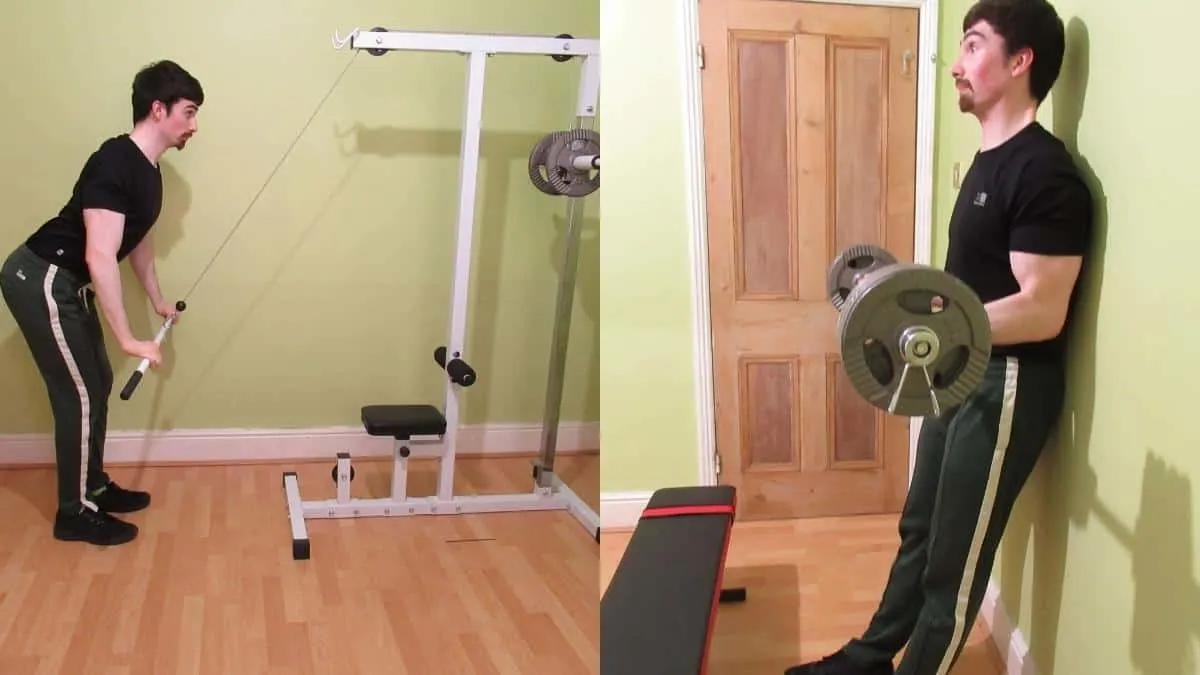If you want to build and strengthen your back muscles and your biceps brachii, then this is the guide for you. In addition to four full back and bicep workouts to get you growing, we’ve handpicked the top 9 exercises for developing your pulling muscles so that you can craft a custom routine should you so desire.
Related: Chest and bicep workout│Back and triceps workout routine
Top 9 best back and biceps workout drills
After trying hundreds of different back and bicep workout drills, we narrowed down the most effective exercises to this top 9 list. You can use these movements to create your own back and bi workout routines, or you can perform them in a circuit style to save time and get a great pump.
1. Lat pulldowns
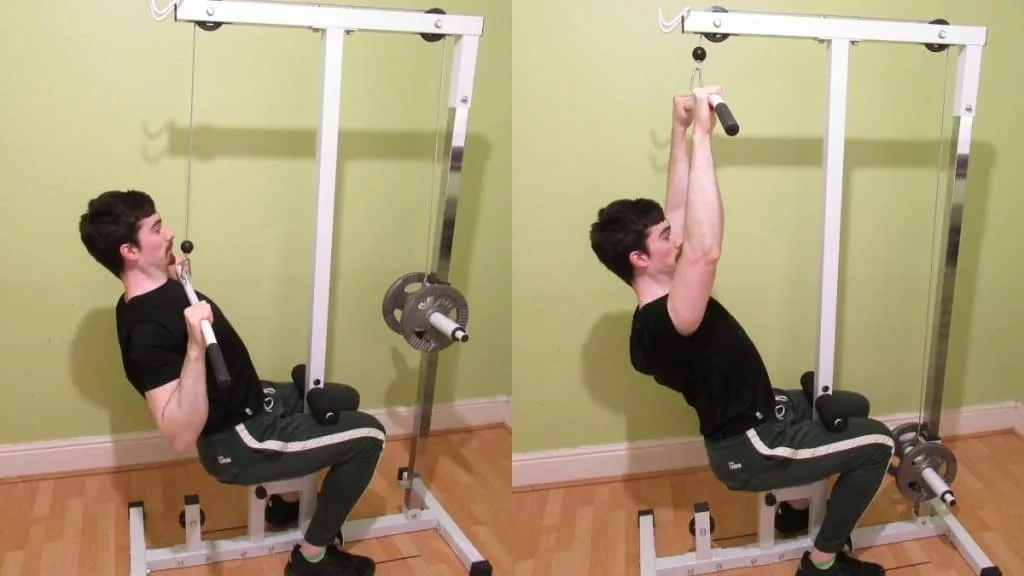
Lat pulldowns should be a part of any hypertrophy-focused bicep and back workout because they build massive amounts of mass throughout the traps and latissimus dorsi. They’re also an extremely accessible exercise that anyone can perform to strengthen their back. For example, not everyone is strong enough to do pull-ups, but pretty much everyone can use the pulldown machine.
The trick is to get a full lat stretch and contraction on every rep. Pull the bar all the way down to your chest, and then release it under control until you feel a deep yet comfortable stretch in your lats. Yes, this may mean decreasing the weight a bit. But by using a full range of motion, you’ll be placing extra tension on your lats and traps by recruiting more muscle fibers.
So please, don’t just lift the bar to your chin and stop; pull it to your chest instead!
- Grab the pulldown bar with a shoulder-width overhand grip and secure your thighs under the pad.
- Arch your upper back slightly and stick your chest out.
- Pull the bar to your chest by contracting your lats and driving your elbows into your sides.
- Release the bar under control (after it touches your chest) until your elbows are almost fully locked out.
- Repeat for 3-5 sets of 8-12 reps.
2. Chin-ups
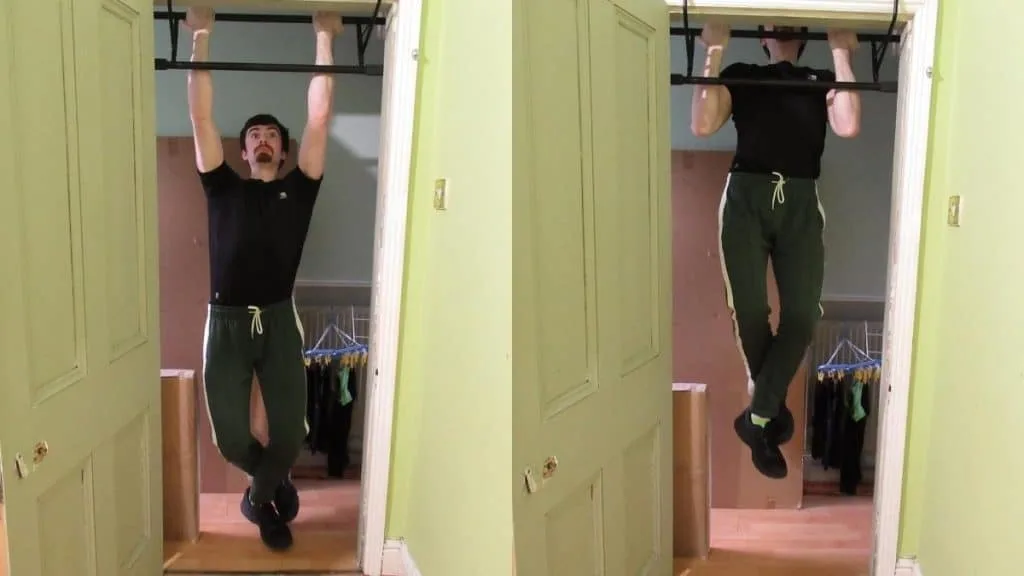
Chin-ups give you a killer back and bicep workout every time because they simultaneously strengthen your lats and biceps. So in this regard, chin-ups are a little less of an isolation exercise than pulldowns, but they can build just as much mass when you perform them consistently.
Plus, they give your core much more stimulation than pulldowns.
Chin-ups also make a great addition to any at home back and bicep workout because all you need to perform them is a basic pull-up bar and a spare 10 minutes. Pulldown machines, on the other hand, are very bulky and typically cost hundreds of dollars at a minimum.
See Also: Home bicep workout
- Grab a pull-up bar with an underhand grip just inside shoulder-width.
- Arch your upper back slightly and ensure that you’re looking straight ahead.
- Pull your chest toward the bar by contracting your biceps and driving your elbows down toward the ground.
- Try and get your chin over the bar, or, better yet, touch your chest to the bar.
- Lower your body under control until your arms are almost, but not quite, locked out.
- Repeat for 3-5 sets of 5-10 reps. Add extra weight if you can already do multiple sets of 10 reps.
3. Incline dumbbell curls
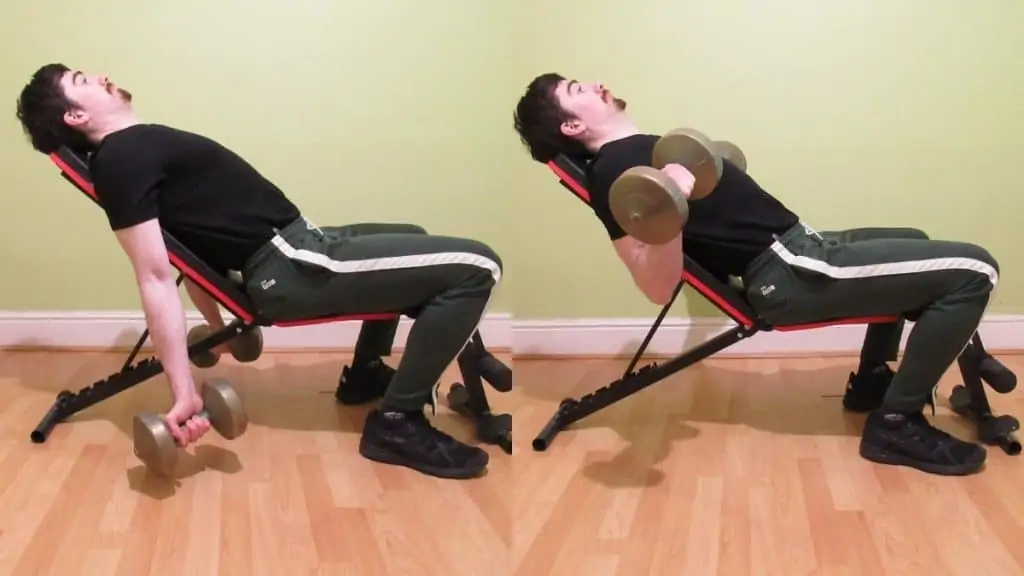
Any good back and biceps workout should include incline curls because, compared to similar exercises, they place greater tension on the biceps during all parts of the lifting motion. This means that you can get the same gains from fewer sets by doing incline curls because each rep is more effective since it provides your biceps with higher tension levels than standard (and especially preacher) curls.
Incline curls emphasize the long head of the biceps by having you curl with your arms behind your body. This is an area of the biceps that many lifters need to work on and which can help to create a better peak.
- Set the backrest of an adjustable bench to between 45 and 60 degrees.
- Grab two dumbbells and sit on the bench.
- Let your arms hang by your sides and slightly behind your torso.
- Curl the weights toward your shoulders while keeping your elbows still.
- Keep curling until the undersides of your forearms press right up against your biceps.
- Lower the dumbbells under control and repeat for 3-5 sets of 8-15 reps.
4. Barbell curls
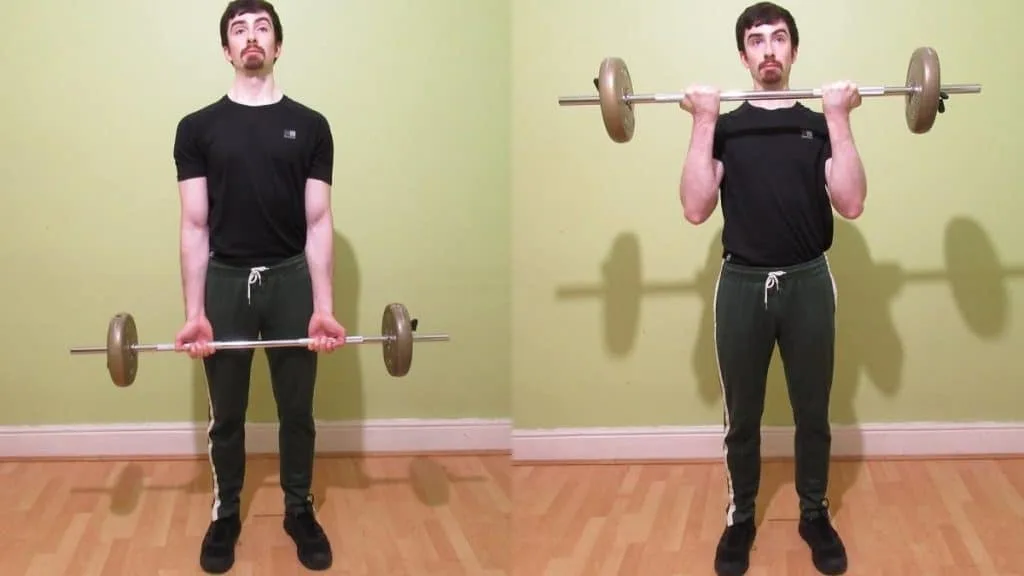
Barbell curls make an excellent addition to any mass-building back bicep workout because they enable you to overload your biceps with more resistance than any other isolation exercise. As such, they’re equally useful for beginners who’re seeking to add a solid foundation of size and bodybuilders who’re looking to take their arm development to the next level.
Since barbell curls are a pure isolation exercise, however, you should use the strictest possible form if you want to stay injury-free and get the most optimal bicep gains. Avoid swinging the bar up with your legs, lower back, or shoulders. Although you can certainly lift heavier weights when you cheat, you won’t actually be putting extra tension on the target muscles (i.e., the biceps) when you lift this way. And tension, after all, is what counts for muscle growth.
- Grab a barbell with a shoulder-width underhand grip and let it rest on the front of your thighs.
- While keeping your elbows and shoulders still, curl the bar toward your chest by contracting your biceps.
- Keep lifting until your forearms and biceps make firm contact.
- Squeeze your biceps at the top of the rep and then lower the bar under control until your elbows reach full extension.
- Perform 3-5 sets of 6-12 reps in total.
5. Cable rows
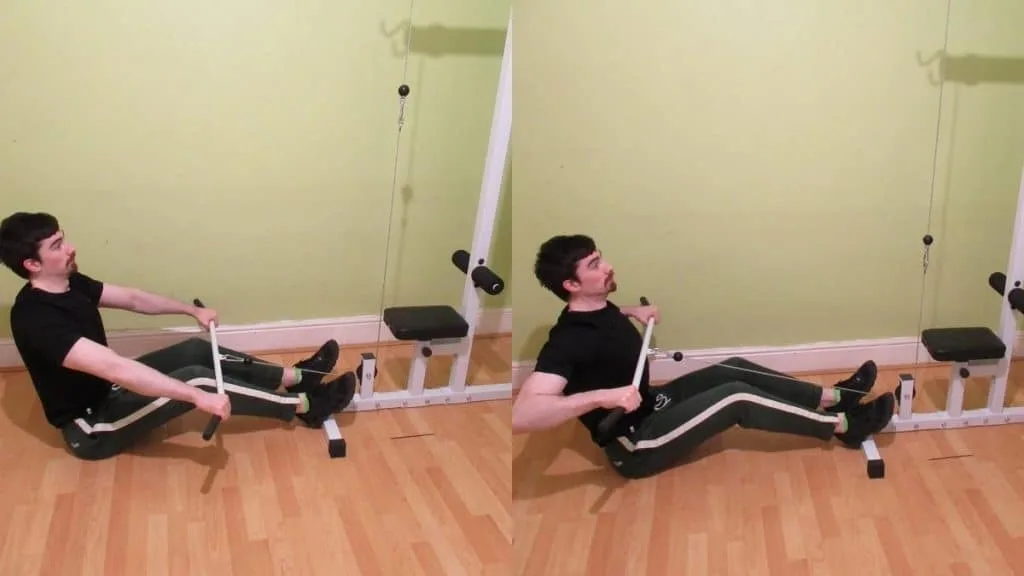
Cable rows train your back and bis in addition to your rear delts. They also provide more consistent tension levels than regular rows, which helps you to get a better back pump.
Best of all, you can easily vary the attachment and your hand position to target different areas of your back. Using a wide grip and flaring your elbows out more, for example, will target your traps. On the other hand, use a narrower grip and keeping your elbows tucked in will shift the emphasis onto your lats.
- Connect your preferred attachment to the cable row station.
- Sit upright and pull the attachment toward your abs by driving your elbows behind your torso.
- Squeeze your back muscles forcefully and then release the cable handle under control for a full lat and trap stretch.
- Perform 3-5 sets of 6-12 reps in total.
6. Barbell rows
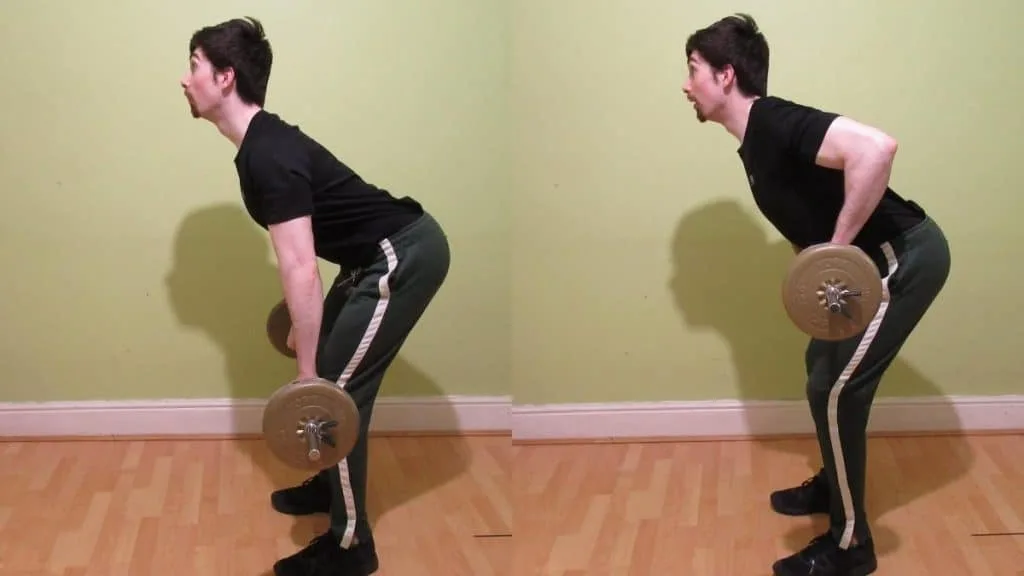
It’s best to include barbell rows at the beginning of your biceps and back workout (say after pull-ups or chin-ups) because they require more core strength than dumbbell and cable exercises. The trade-off is that they also build slabs of mass across your lats, traps, and rear delts. That’s why barbell rows are so popular among those seeking new size gains.
Again, you can vary your grip, elbow position, and torso angle to target different regions of your back. Staying more upright will shift the emphasis onto your upper and mid traps, as will flaring your elbows out. Bending over more makes your spinal erectors work harder and also creates a stronger peak contraction. Additionally, it makes the movement more difficult.
For overall mass, follow the guidelines below.
- Grab a barbell with a shoulder-width overhand grip.
- Bend over so that your torso is at a 45-degree angle.
- Row the bar into your abs by driving your elbows behind your body.
- Contract your back muscles as the bar touches your abs.
- Slowly lower the bar back down until your elbows are fully extended.
- Repeat for 3-5 sets of 6-10 reps.
7. Bicep curls
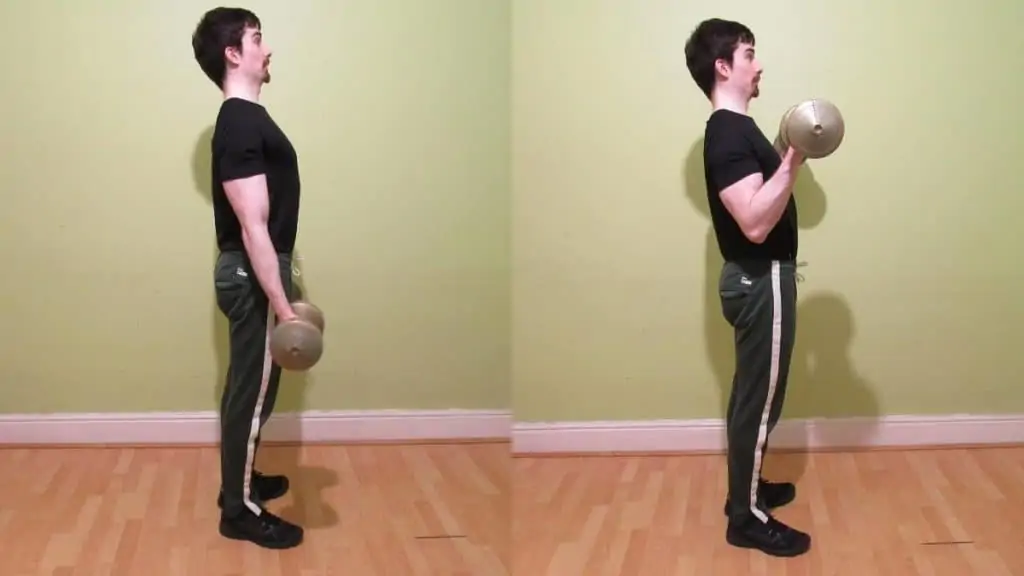
You should do some kind of dumbbell curl in every back and bicep workout routine so that you can sculpt symmetrical biceps and minimize the risk of developing awkward-looking muscular imbalances. Performing bicep curls with dumbbells also enables you to generate an intense muscle contraction by forcefully supinating your wrists at the top of every rep.
So if you’re doing a back and bicep workout with dumbbells or a back shoulder and bicep workout, make sure to perform curls after you’ve done your rows because rows don’t train the biceps in their optimal, supinated position.
- Hold a pair of dumbbells by your sides with an underhand grip.
- Curl the weights toward your shoulders by flexing your biceps.
- Keep on curling until the undersides of your forearms make forceful contact with your biceps.
- Hold the contraction for a second, and then lower the dumbbells under control until your elbows reach full extension.
- Repeat for 3-5 sets of 6-15 reps.
8. Reverse curls
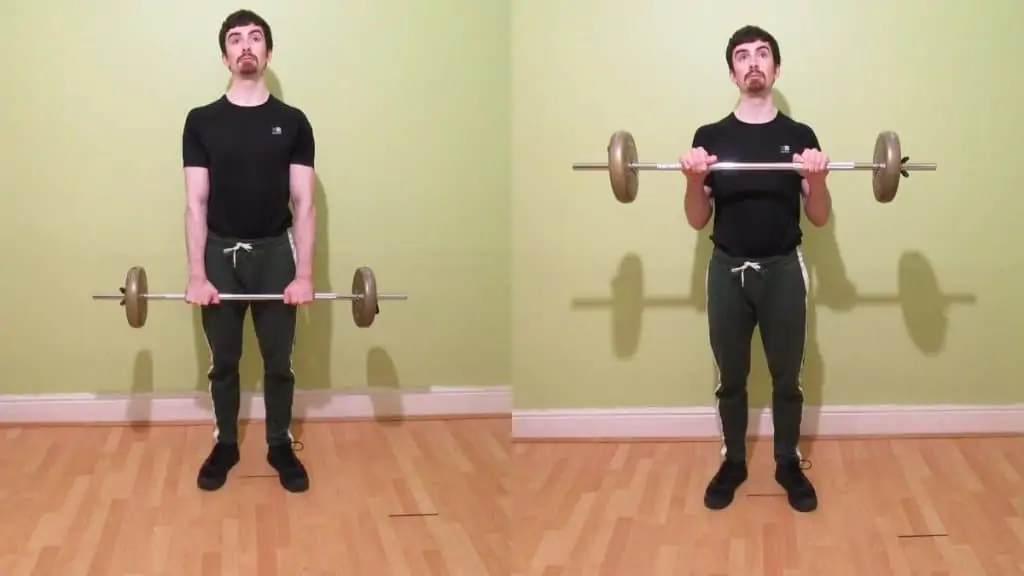
No muscle-building back and biceps day is complete without the reverse curl. This underrated exercise trains the brachioradialis, brachialis, and, to a lesser extent, the biceps themselves. The former two muscles are areas that many lifters neglect. So if you want to achieve complete upper arm development, make sure that you’re doing some kind of reverse curl during your back and bis workout.
The training tool of choice for reverse curls is the Olympic barbell so that you can overload your arms with the heaviest possible resistance. But if you want to train each arm individually to minimize the chance of uneven muscle development, then you can also opt for dumbbells instead.
- Grab a barbell with an overhand grip, just inside shoulder-width.
- Curl the bar toward your chest.
- Keep lifting until the tops of your forearms press up against your biceps.
- Pause at the top of the rep for a split second and then lower the weight under control until your arms are fully locked out.
- Repeat the motion for 3-5 sets of 8-15 reps.
9. Straight arm lat pulldown
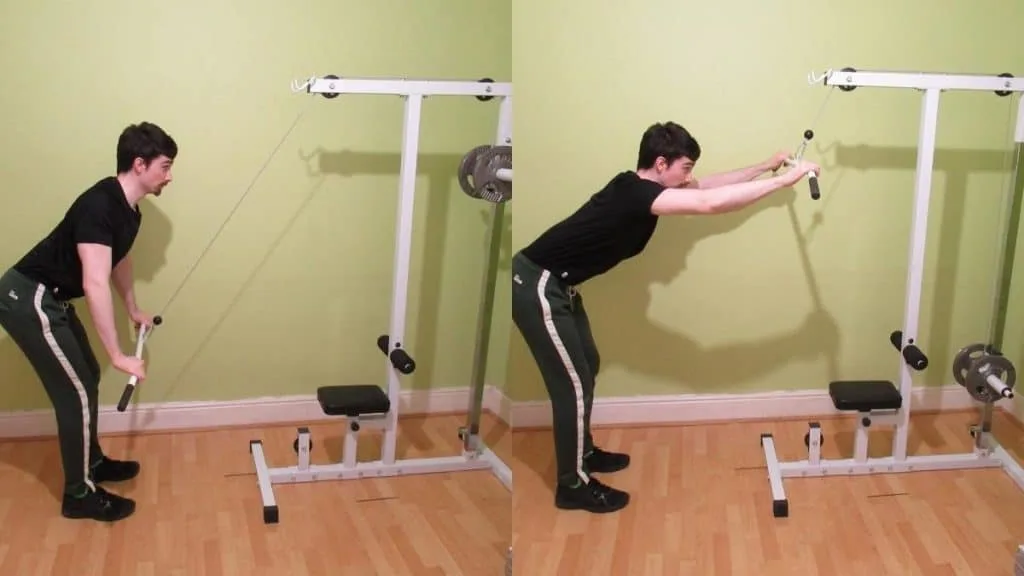
If you’re doing your back and bicep workout at home, then you probably won’t be able to take advantage of the straight arm lat pulldown. However, if you’re training in a well-equipped gym, then lat pushdowns are an excellent exercise for isolating your lats and ensuring that they reach muscular failure on their own.
And while pulldowns and the like can certainly build your back, it’s best to isolate your muscles for optimal growth. After all, would you ever just do chin-ups for your biceps and leave things at that? Probably not. So don’t do it for your lats either if you want your back to reach its full potential.
- Connect a wide bar to a high pulley and grab it with an overhand grip.
- While holding the bar, take a few steps backward and bend over at the waist sightly.
- Make sure that your arms are fully extended in front of you.
- Pull the bar down by flexing your lats.
- Keep pulling the bar down until your palms touch your thighs and your lats are maximally contracted.
- Release the bar (under control) back to the starting position and repeat for 3-5 sets of 10-15 reps.
Related Workout: Back biceps abs workout
At home back and bicep workout
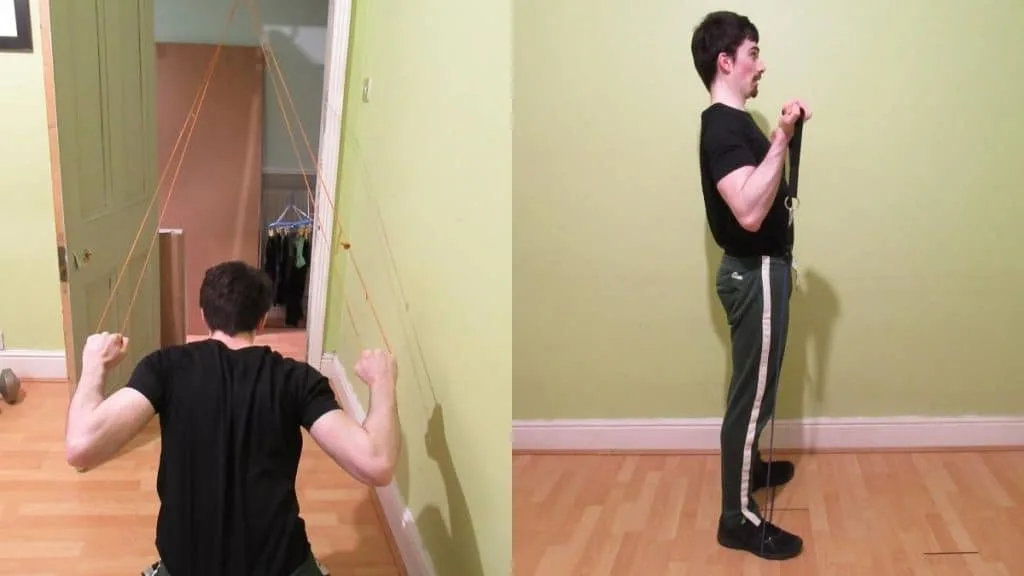
Workout 1
1: Chin-ups — 3-5 sets of 5-10 reps
2: Resistance band rows — 3-5 sets of 15-30 reps
3: Banded pulldowns— 3-4 sets of 12-15 reps
4: Dumbbell curls — 3-5 sets of 8-12 reps
5: Resistance band reverse curl — 3-4 sets of 12-20 reps
Workout 2
1: Chin-ups — 3-5 sets of 5-10 reps
2: Dumbbell rows — 3-5 sets of 6-12 reps
3: Band pulldowns — 3-4 sets of 12-15 reps
4: Band curls — 3-5 sets of 12-20 reps
5: Resistance band hammer curl — 3-5 sets of 12-20 reps
Give this at home back and biceps workout a try if you only have minimal equipment but still want to build muscle. Although barbells are undeniably convenient for building mass, you can still make excellent gains by using dumbbells and bands as long as you train close enough to muscular failure and perform sufficient volume. [1]
The first back and bicep home workout starts with heavy chin-ups to build overall lat and bicep size. But if you want to take your biceps more or less out of the equation and save them for the isolation exercises later in the workout, then you can do pull-ups instead.
Then you’ll move onto high reps rows. The upper traps respond excellently to this exercise, and it’s effortless to set up for at home if you have a pull-up bar.
Next up, you’ll be doing single-arm band pulldowns so that you can develop large, symmetrical lats that will enhance your v-taper.
The session ends with some dumbbell bicep exercises and then reverse curls. These two movements ensure that all the muscle fibers in your arms get recruited.
The second at home back and bicep workout follows much the same pattern. You start with heavy chin-ups before moving into rows. This time, however, you’ll be doing dumbbell rows and lifting heavier. Compared to resistance band high rows, the dumbbell version is better for building the lats but less effective for developing the upper (and perhaps even mid) traps.
Finally, there’s some more isolation work to finish off your biceps, brachialis, and brachioradialis. You can definitely do resistance band bicep curls if you don’t have access to dumbbells.
Of course, feel free to mix exercises from both routines. These programs are solid and well-thought-out (if I do say so myself), but they’re not magic. There’s no one secret back bi workout to get you those gains. The most important things are that you’re training hard enough (i.e., close enough to failure) and accumulating sufficient training volume across the session, week, and mesocycle. [2]
Back and bicep workout for cutting

1: Pull-ups — 3-5 sets of 6-10 reps
2: Neutral-grip pulldown — 3-5 sets of 8-12 reps
3: Cable row — 4-5 sets of 8-15 reps
4: Shrugs — 3-4 sets of 10-15 reps
5: Incline dumbbell curl — 3-5 sets of 6-10 reps
6: Preacher curl — 3-4 sets of 8-12 reps
7: Reverse curl — 3-4 sets of 10-15 reps
8: Barbell drag curl — 2 sets of 15-20 reps (optional)
When you’re doing a back and bicep workout for cutting, it’s essential to perform enough training volume to maintain your muscle mass while you’re in a calorie deficit. [3] Yet, you also don’t want to overtrain because doing so will eat into your recovery capacities, which are naturally more limited when you’re in an energy deficit.
This routine isn’t for beginners because novice lifters shouldn’t be cutting. But if you’ve already got a solid amount of mass and want to shape up for summer or for a show, then this is one of the best back bicep workout routines that you can do to preserve your muscle mass.
The session kicks off with pull-ups, which should feel more manageable now that you’re dropping body fat. Then it’s time to really hone in on the meat of the lats with neutral-grip pulldowns. Make sure to get a full stretch and contraction on every rep for the best results.
Next up is the cable row to train the traps. It’s recommended to use a wider grip and flare your elbows out to really work on that critical back thickness that every bodybuilder needs.
Shrugs will take care of the upper traps nicely. I prefer dumbbells, but using a barbell will work just as well for maintaining size on a cut.
The bicep work begins with incline curls to focus on the long head and overall mass. Then you’ll do preacher curls for maximum muscle isolation. Next, you’ll take care of your brachialis and brachioradialis with reverse curls, and finally—if you’ve still got the energy—you can end this killer back and biceps workout with the drag curl.
You can also switch out drag curls for the spider curl. Try both movements and see which gives you a better pump.
Back and bicep workout with dumbbells
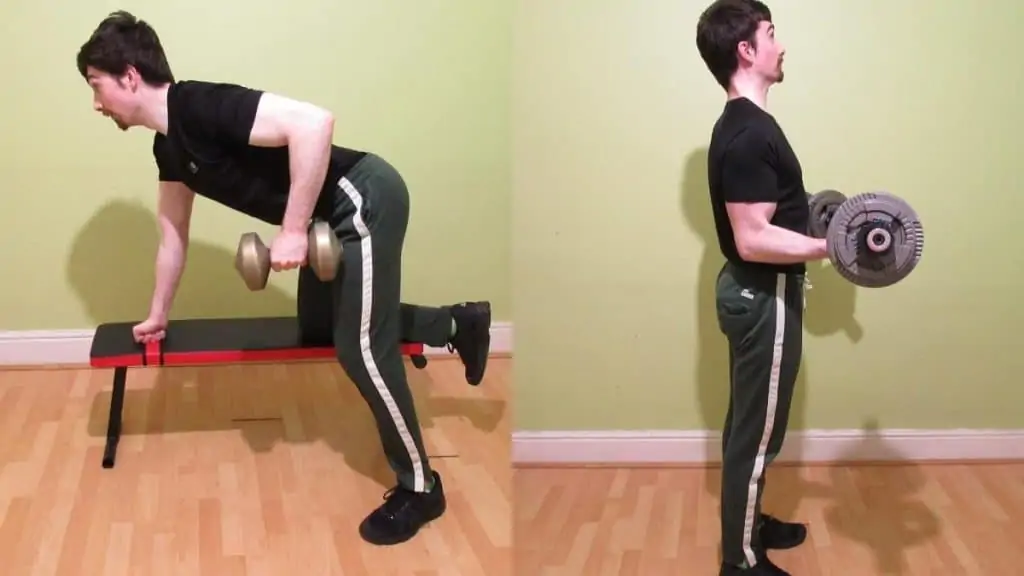
1: Dumbbell rows — 4-5 sets of 8-12 reps
2: Rear delt rows — 3-5 sets of 10-15 reps
3: Shrugs — 3-5 sets of 12-15 reps
4: Hammer curl — 3-5 sets of 6-12 reps
5: Concentration curl — 3-5 sets of 8-15 reps
6: Zottman curl — 3 sets of 10-12 reps
Only got dumbbells? No problem. Here’s a mass-building dumbbell back and bicep workout that you can do at home or in the gym. Just make sure to read the workout description below very carefully because the devil is in the detail; it’s all about the exercise execution.
Dumbbell rows are the first exercise. However, you want to row the dumbbell up and back to engage your lats as much as possible. The reason being is that in this dumbbell back and biceps workout, you won’t be doing any pull-ups or pulldowns. Therefore, you want to make one of the rowing movements as lat-focused as possible. So think about dragging your elbow backward as you row the dumbbell.
Rear delt rows are up next. This movement also works the traps to a large extent. The difference is that you’ll be rowing with your elbows flared out to the sides, which means that you’ll need to lift lighter since your lats and biceps will be less engaged.
If you already have good traps, then you can actually skip shrugs and do a different lat-dominant movement (like band pulldowns if you have resistance bands). Nonetheless, the upper traps are an important area that many men want to develop; that’s why they’re in this back bicep routine.
As with any good back and bi workout, the session winds down with isolation exercises for the arms. The hammer curl enables you to lift heavier than regular curls; thus, you’ll be starting with them. Then you’ll be honing in on each individual bicep with the concentration curl so that you can build muscle symmetry and avoid uneven bicep development.
Zottman curls are a tough finisher that will build your brachialis and brachioradialis as well as your biceps. Try and slow down the eccentrics here, if you can, because the brachialis responds particularly well to slow negatives and high reps.
Back and bicep workout for beginners

1: Barbell row — 4-5 sets of 6-10 reps
2: Lat pulldown — 4-5 sets of 8-12 reps
3: Barbell curl — 3 sets of 8-12 reps
4: Face pull — 3 sets of 12-15 reps
These back and bicep exercises are simple yet effective. So if you’re a weight lifting beginner or are getting back into training after a layoff, this back and bicep routine will provide just the right amount of volume to stimulate new muscle growth.
Barbell rows will increase the size of your traps and make your back look thicker when viewed from behind. Like the face pulls you’ll be doing at the end of the workout, heavy rows will also add mass to your rear delts and thus make your shoulders look more three-dimensional.
Lat pulldowns, as the name suggests, mainly work the lats. Getting strong at this exercise will broaden your back from all angles and give your physique a better v taper.
Performing barbell curls (with good form) is one of the fastest ways to build your biceps because by using bars rather than dumbbells, you’re able to overload your biceps with more resistance. So make sure to include them in your beginner bicep workout if you’re a novice lifter who’s trying to build mass.
If the straight bar hurts your wrist, however, then you can do the EZ bicep curl instead.
Conclusion: How to have an effective back and biceps workout every time
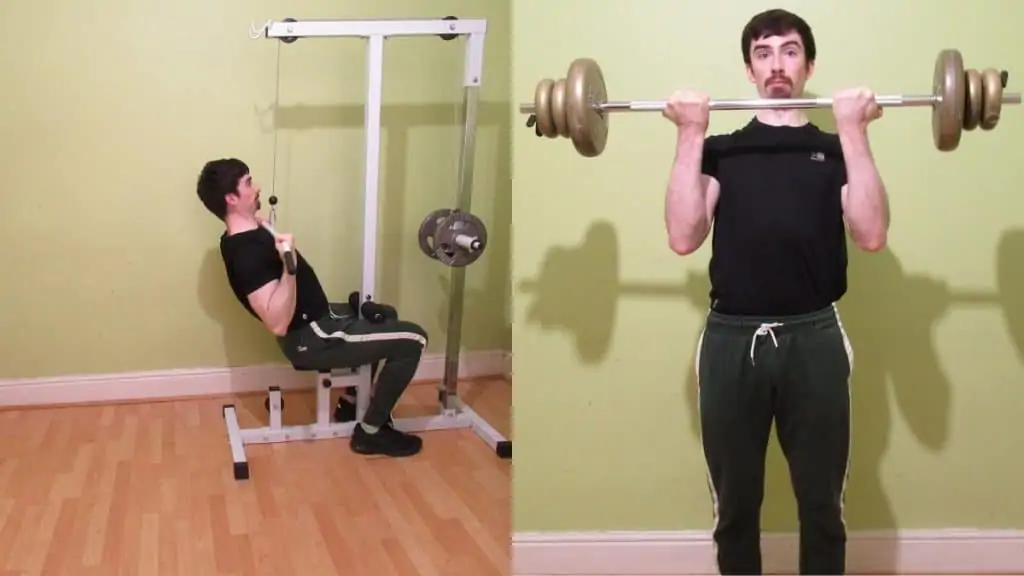
While there isn’t a single best back and bicep workout that’s optimal for everyone, following the general guidelines laid out in this article will help you to get the best results that your genetics are capable of producing.
Specifically, make sure that you’re doing at least one vertical pull (like lat pulldowns) and one horizontal pull (like barbell rows) in each workout. This is because vertical pulls prioritize the lats, whereas horizontal pulls mainly work the traps. So by doing both types of exercises, you’ll be achieving optimal back development.
Why no deadlifts in any of the back and biceps workouts?
Deadlifts work all the muscles in the back. However, they aren’t optimal for any single one of those muscles. So, while they can and do lead to muscle growth, your time and energy are simply better spent on exercises like rows and pulldowns if you’re training for hypertrophy.
You can also see our back and bicep workout for women if you’re after a female-specific program. Or, if you don’t have much equipment, you can check out our back and bicep resistance band workout for a list of accessible exercises.
References
- Campos, G., Luecke, T., Wendeln, H., Toma, K., Hagerman, F., Murray, T., Ragg, K., Ratamess, N., Kraemer, W., & Staron, R. (2002). Muscular adaptations in response to three different resistance-training regimens: specificity of repetition maximum training zones. European Journal of Applied Physiology, 88(1–2), 50–60. https://doi.org/10.1007/s00421-002-0681-6
- Grgic, J., Schoenfeld, B. J., Orazem, J., & Sabol, F. (2021). Effects of resistance training performed to repetition failure or non-failure on muscular strength and hypertrophy: A systematic review and meta-analysis. Journal of Sport and Health Science. Published. https://doi.org/10.1016/j.jshs.2021.01.007
- Helms, E. R., Aragon, A. A., & Fitschen, P. J. (2014). Evidence-based recommendations for natural bodybuilding contest preparation: nutrition and supplementation. Journal of the International Society of Sports Nutrition, 11(1). https://doi.org/10.1186/1550-2783-11-20

